A New Tree-Type Fracturing Method for Stimulating Coal Seam Gas Reservoirs
Abstract
:1. Introduction
2. Synopsis of the New Tree-Type Fracturing Technology
2.1. Tree-Type Fracturing Method
2.2. Tree-Type Sub-Borehole Fracture Theory
2.3. Gas Seepage after Tree-Type Fracturing
3. Tree-Type Fracturing Laboratory Experiments
3.1. Experimental Apparatus
3.2. Experimental Procedures
- (1)
- The sample carrier was sealed with a load-bearing cover by using adhesive (Figure 3c) and then placed into the triaxial loading cavity and fixed by four mechanical loading plates (Figure 3d). The gas inlet and outlet pipes and the water injection pipe were then connected to the cover. Screens were inserted to make sure the sample was not in direct contact with the cover to ensure that the sample had full contact with seepage gas. The loading cavity was then closed and sealed.
- (2)
- Hydraulic oil was pumped into the loading cavity until the confining pressure reached the minimum horizontal principal stress σh. Then the axial and lateral stresses were loaded to vertical principal stress σv and the maximum horizontal principal stress σH by the servo pumps at a rate of 2 MPa/min. Next, but before fracturing was initiated, gas was injected into the sample to test sample permeability and to simulate pore pressure. Methane was used as the pore gas during testing. Gas was injected from the plane marked as “a” in Figure 3a and ejected from plane “c”. The injection pressure was 2.5 MPa [28]. When the flow of ejected gas was stable, the gas flow was used to calculate permeability [29,30]. The permeability experiments on Φ50 × 100 mm sandstone specimens taken from different directions showed that the sandstone has isotropic properties, so the permeability at a single direction can represent the permeability of sandstone [31].
- (3)
- After connecting the syringe pump to the simulated main borehole in the sample (by a steel tube), the real-time data acquisition system was started. The two pump plungers were filled with distilled water and then the pump was started to inject high-pressure water at the specified flow rate of 20 mL/min. The injection system pressurized until a rapid pressure drop, which indicated that the sample had fractured. The pump was shut off after the sample was fractured completely.
- (4)
- After fracturing, the water was drained and the gas injection system was started to conduct the gas seepage tests. Gas was injected from planes a, b and c, shown in Figure 3a, with the simulated main borehole serving as a gas outlet to measure stimulated gas production after fracturing.
3.3. Results
4. Tree-Type Fracturing Case Study
4.1. Test Site and Procedures
4.2. Results and Discussion
5. Conclusions
Acknowledgments
Author Contributions
Conflicts of Interest
References
- Tian, L.; Cao, Y.X.; Chai, X.Z.; Liu, T.J.; Feng, P.W.; Feng, H.M.; Zhou, D.; Shi, B.; Oestreich, R.; Rodvelt, G. Best practices for the determination of low-pressure/permeability coalbed methane reservoirs, Yuwu Coal Mine, Luan mining area, China. Fuel 2015, 160, 100–107. [Google Scholar] [CrossRef]
- Hu, G.Z.; Xu, J.L.; Zhang, F.X.; Zhao, C.C.; Qin, W.; Zhu, Y.R. Coal and coalbed methane co-extraction technology based on the ground movement in the Yangquan coalfield, China. Energies 2015, 8, 6881–6897. [Google Scholar] [CrossRef]
- Ranathunga, A.S.; Perera, M.S.A.; Ranjith, P.G. Deep coal seams as a greener energy source: A review. J. Geophys. Eng. 2014, 11, 063001. [Google Scholar] [CrossRef]
- Mu, C.M.; Wang, H.L.; Huang, W.Y.; Kuang, C.J. Increasing permeability mechanism using directional cumulative blasting in coal seams with high concentration of gas and low permeability. Rock Soil Mech. 2013, 34, 2496–2500. [Google Scholar]
- Lu, T.K.; Yu, H.; Zhou, T.Y.; Mao, J.S.; Guo, B.H. Improvement of methane drainage in high gassy coal seam using waterjet technique. Int. J. Coal Geol. 2009, 79, 40–48. [Google Scholar] [CrossRef]
- Kong, X.G.; Wang, E.Y.; Liu, X.F.; Li, N.; Chen, L.; Feng, J.J.; Kong, B.; Li, D.X.; Liu, Q.L. Coupled analysis about multi-factors to the effective influence radius of hydraulic flushing: Application of response surface methodology. J. Nat. Gas Sci. Eng. 2016, 32, 538–548. [Google Scholar] [CrossRef]
- Zhang, Z.B.; Li, X. Numerical study on the formation of shear fracture network. Energies 2016, 9, 299. [Google Scholar] [CrossRef]
- Westwood, R.F.; Toon, S.M.; Styles, P.; Cassidy, N.J. Horizontal respect distance for hydraulic fracturing in the vicinity of existing faults in deep geological reservoirs: A review and modelling study. Geomech. Geophys. Geo-Energy Geo-Resour. 2017, 3, 1–13. [Google Scholar] [CrossRef]
- Huang, B.X.; Liu, C.Y.; Fu, J.H.; Guan, H. Hydraulic fracturing after water pressure control blasting for increased fracturing. Int. J. Rock Mech. Min. Sci. 2011, 48, 976–983. [Google Scholar] [CrossRef]
- Zhai, C.; Li, M.; Sun, C.; Zhang, J.G.; Yang, W.; Li, Q.G. Guiding-controlling technology of coal seam hydraulic fracturing fractures extension. Int. J. Min. Sci. Technol. 2012, 22, 831–836. [Google Scholar] [CrossRef]
- Fan, J.; Dou, L.M.; He, H.; Du, T.T.; Zhang, S.B.; Gui, B.; Sun, X.L. Directional hydraulic fracturing to control hard-roof rockburst in coal mines. Int. J. Min. Sci. Technol. 2012, 22, 177–181. [Google Scholar] [CrossRef]
- Wang, Y.F.; Li, Y.Z. Technology and application of directional hydraulic penetration permeability improvement by guided groove. J. China Coal Soc. 2012, 37, 1326–1331. [Google Scholar]
- Liu, Y.; Xia, B.W.; Liu, X.T. A novel method of orienting hydraulic fractures in coal mines and its mechanism of intensified conduction. J. Nat. Gas Sci. Eng. 2015, 27, 190–199. [Google Scholar] [CrossRef]
- Zou, Q.L.; Lin, B.Q.; Zheng, C.S.; Hao, Z.Y.; Zhai, C.; Liu, T.; Liang, J.Y.; Yan, F.Z.; Yang, W.; Zhu, C.J. Novel integrated techniques of drilling-slotting-separation-sealing for enhanced coal bed methane recovery in underground coal mines. J. Nat. Gas Sci. Eng. 2015, 26, 960–973. [Google Scholar] [CrossRef]
- Yan, F.Z.; Lin, B.Q.; Zhu, C.J.; Shen, C.M.; Zou, Q.L.; Guo, C.; Liu, T. A novel ECBM extraction technology based on the integration of hydraulic slotting and hydraulic fracturing. J. Nat. Gas Sci. Eng. 2015, 22, 571–579. [Google Scholar] [CrossRef]
- Kozlowska, M.; Orlecka-Sikora, B.; Rudzinski, L.; Cielesta, S.; Mutke, G. A typical evolution of seismicity patterns resulting from the coupled natural, human-induced and coseismic stresses in along wall coal mining environment. Int. J. Rock Mech. Min. Sci. 2016, 86, 5–15. [Google Scholar]
- Lu, Y.Y.; Zhou, Z.; Ge, Z.L.; Zhang, X.W.; Li, Q. Research on and design of a self-propelled nozzle for the tree-type drilling technique in underground coal mines. Energies 2015, 8, 14260–14271. [Google Scholar] [CrossRef]
- Green, A.E.; Sneddon, I.N. The distribution of stress in the neighbourhood of a flat elliptical crack in an elastic solid. Math. Proc. Camb. Philos. Soc. 1950, 46, 159–163. [Google Scholar] [CrossRef]
- Palmer, I.D. Induced Stresses Due to Propped Hydraulic Fracture in Coalbed Methane Wells. In Proceedings of the Low Permeability Reservoirs Symposium, Denver, CO, USA, 26–28 April 1993. [Google Scholar]
- Pollard, D.D.; Holzhausen, G. On the mechanical interaction between a fluid-filled fracture and the earth’s surface. Tectonophysics 1979, 53, 27–57. [Google Scholar] [CrossRef]
- Olson, J.E. Joint pattern development: Effects of subcritical crack growth and mechanical crack interaction. J. Geophys. Res. 1993, 98, 12251–12265. [Google Scholar] [CrossRef]
- Cipolla, C.L.; Warpinski, N.R.; Mayerhofer, M.J.; Lolon, E.P.; Vincent, M.C. The relationship between fracture complexity, reservoir properties, and fracture-treatment design. Soc. Pet. Eng. 2010, 25, 438–452. [Google Scholar] [CrossRef]
- Willis-Richards, J.; Watanabe, K.; Takahashi, H. Progress toward a stochastic rock mechanics model of engineered geothermal systems. J. Geophys. Res. 1996, 101, 17481–17496. [Google Scholar] [CrossRef]
- Hossain, M.M.; Rahman, M.K.; Rahman, S.S. A shear dilation stimulation model for production enhancement from naturally fractured reservoirs. Soc. Pet. Eng. 2002, 7, 183–195. [Google Scholar] [CrossRef]
- Rubin, B. Accurate simulation of non-darcy flow in stimulated fractured shale reservoirs. Soc. Pet. Eng. 2010. [Google Scholar] [CrossRef]
- Braester, C.; Thunvik, R. Determination of formation permeability by double-packer tests. J. Hydrol. 1984, 72, 375–389. [Google Scholar] [CrossRef]
- Xu, R.T.; Li, H.J.; Guo, C.C.; Hou, Q.L. The mechanisms of gas generation during coal deformation: Preliminary observations. Fuel 2014, 117, 326–330. [Google Scholar] [CrossRef]
- Viete, D.R.; Ranjith, P.G. The mechanical behaviour of coal with respect to CO2 sequestration in deep coal seams. Fuel 2007, 86, 2667–2671. [Google Scholar] [CrossRef]
- Ranathunga, A.S.; Perera, M.S.A.; Ranjith, P.G.; Wei, C.H. An experimental investigation of applicability of CO2 enhanced coal bed methane recovery to low rank coal. Fuel 2017, 189, 391–399. [Google Scholar] [CrossRef]
- Ranathunga, A.S.; Perera, M.S.A.; Ranjith, P.G.; Sliva, G.P.D.D. A macro-scale view of the influence of effective stress on carbon dioxide flow behaviour in coal: An experimental study. Geomech. Geophys. Geo-Energy Geo-Resour. 2017, 3, 13–28. [Google Scholar] [CrossRef]
- Pride, S.R.; Berryman, J.G.; Commer, M.; Nakagawa, S.; Newman, G.A.; Vasco, D.W. Changes in geophysical properties caused by fluid injection into porous rocks: Analytical models. Geophys. Prospect. 2017, 65, 766–790. [Google Scholar] [CrossRef]
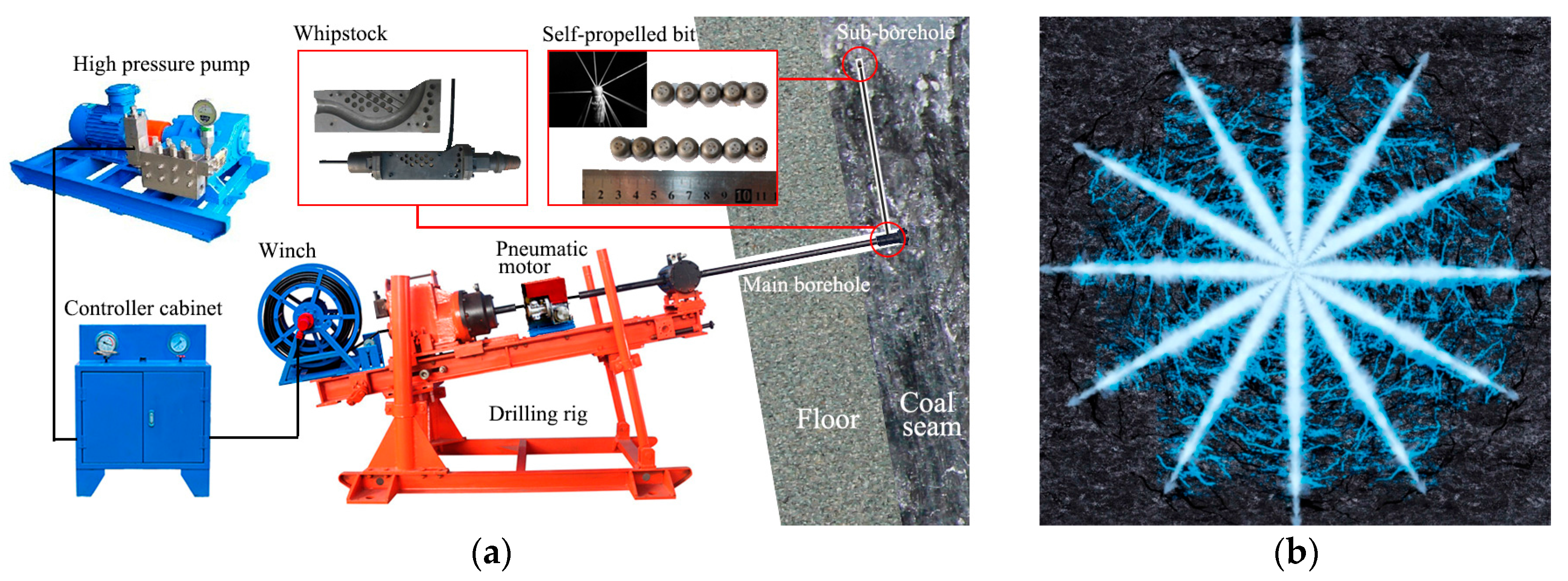

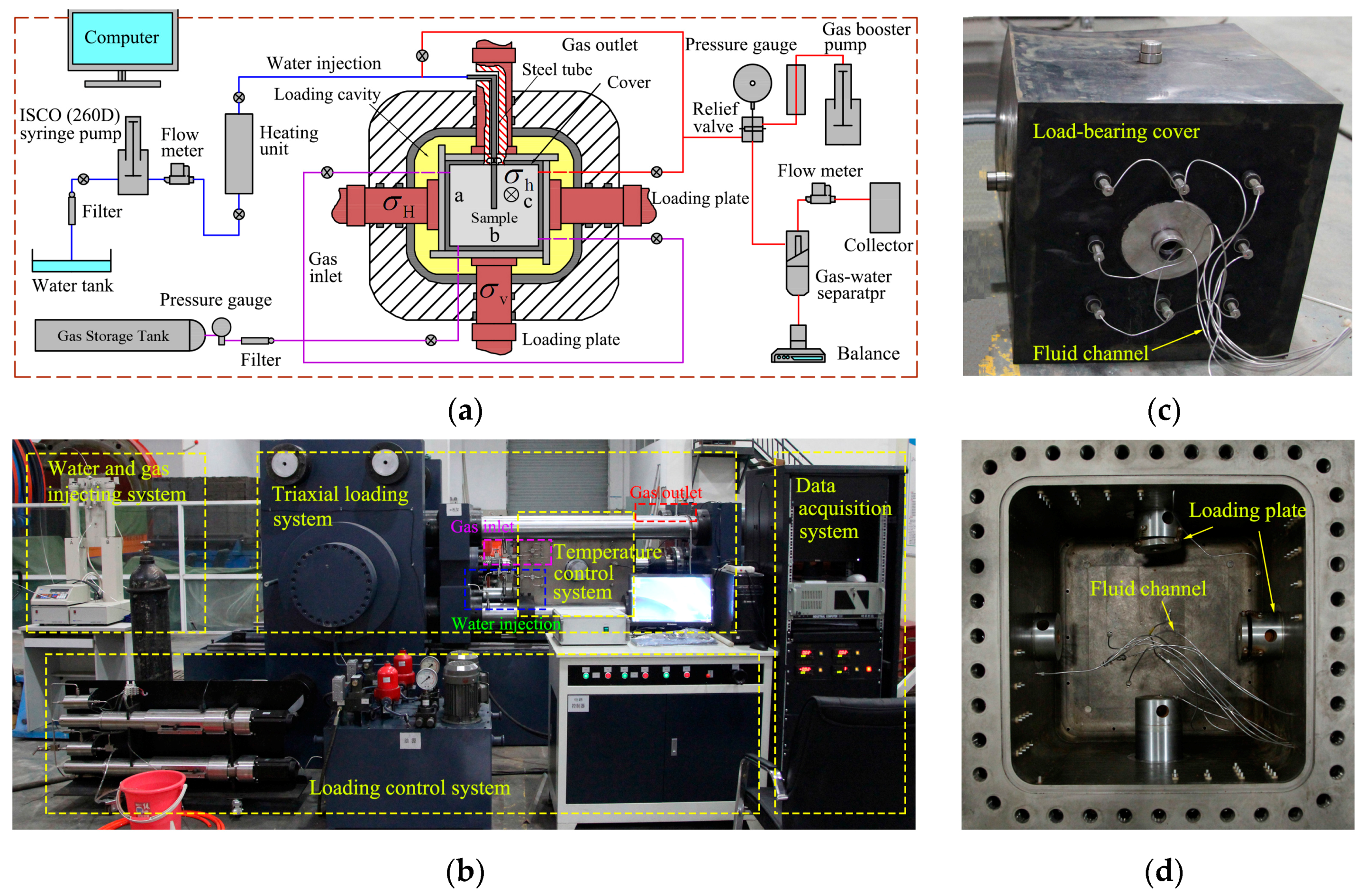

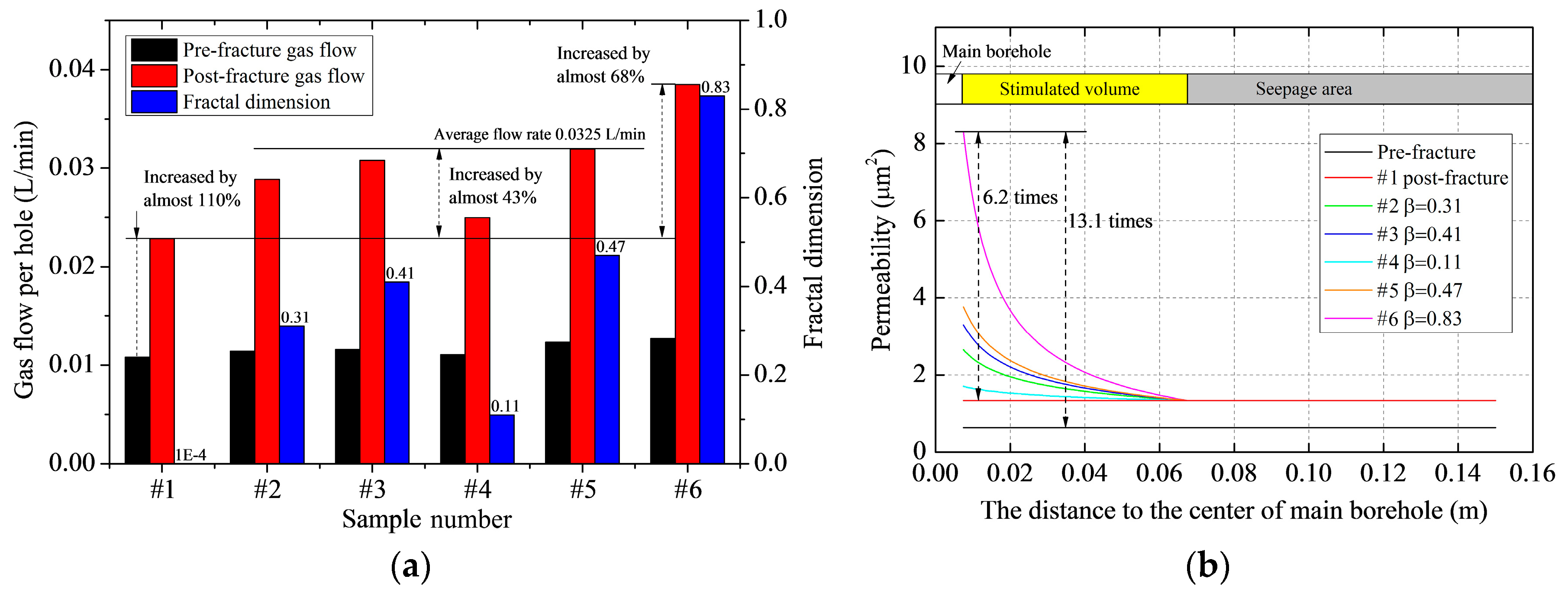
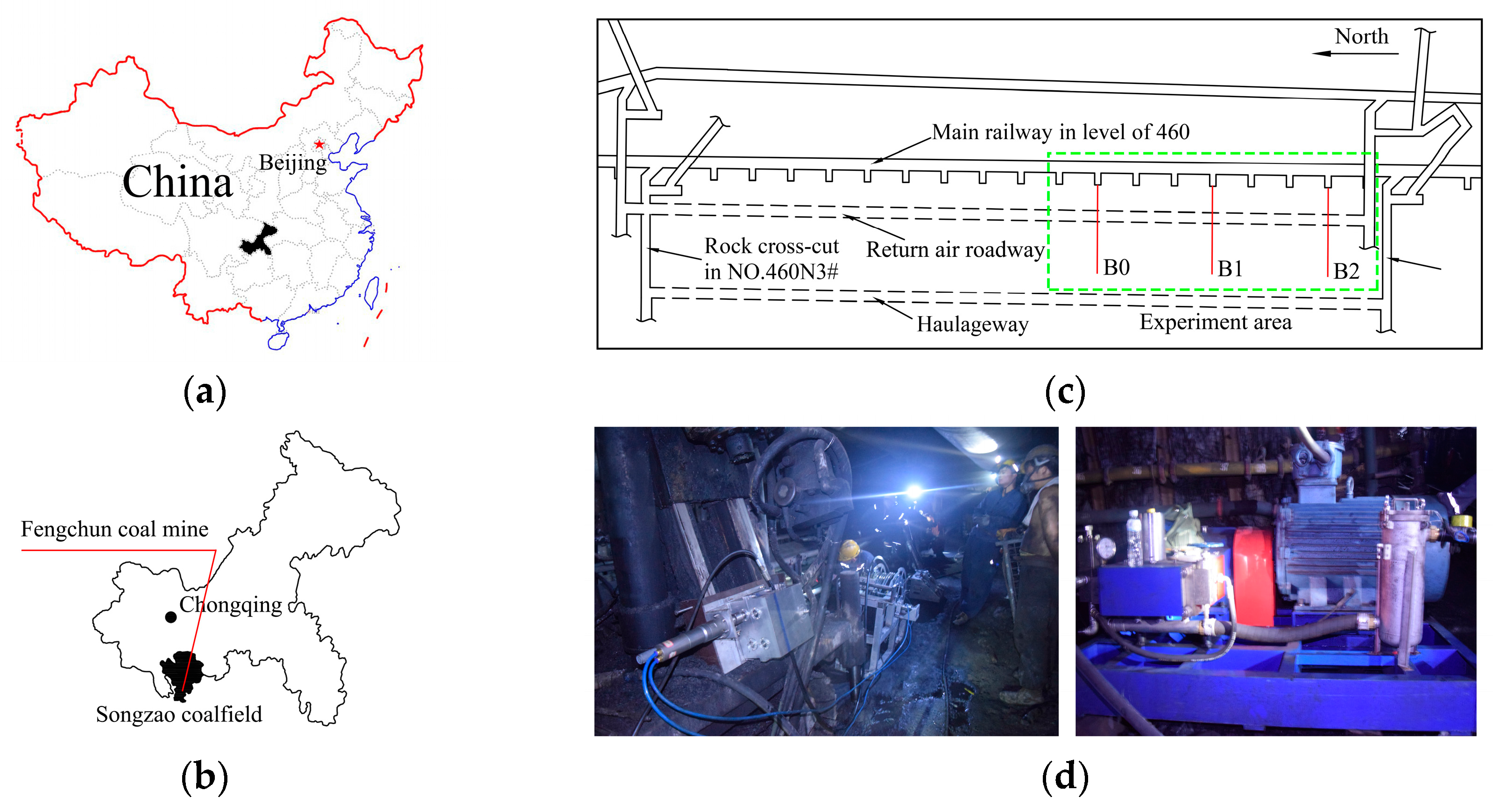
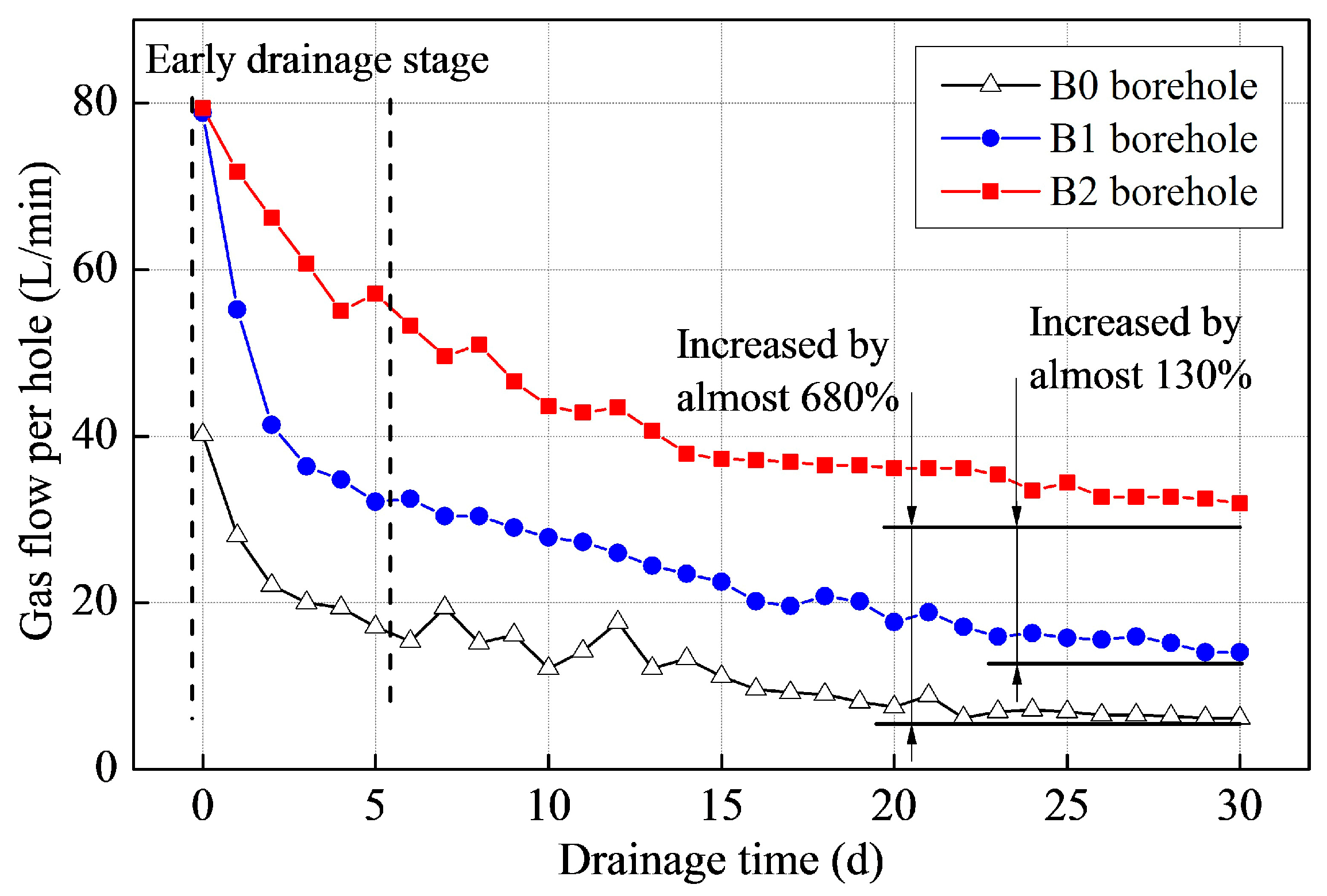
| Sample Number | Triaxial Stresses σv/σH/σh (MPa) | Horizontal Stress Difference (MPa) | The Number of Sub-Boreholes | Initiation Pressure (MPa) | The Induced Stress (MPa) | Whether Fractures Are Induced? |
|---|---|---|---|---|---|---|
| #1 | 15/12/8 | 4 | 0 | 17.22 | ---- | ---- |
| #2 | 15/12/8 | 4 | 3 | 15.24 | 5.69 | Yes |
| #3 | 15/12/7 | 5 | 3 | 14.02 | 5.23 | Yes |
| #4 | 15/12/6 | 6 | 3 | 10.18 | 3.80 | No |
| #5 | 15/12/6 | 6 | 4 | 10.06 | 6.88 | Yes |
| #6 | 15/12/6 | 6 | 6 | 9.25 | 7.64 | Yes |
© 2017 by the authors. Licensee MDPI, Basel, Switzerland. This article is an open access article distributed under the terms and conditions of the Creative Commons Attribution (CC BY) license (http://creativecommons.org/licenses/by/4.0/).
Share and Cite
Li, Q.; Lu, Y.; Ge, Z.; Zhou, Z.; Zheng, J.; Xiao, S. A New Tree-Type Fracturing Method for Stimulating Coal Seam Gas Reservoirs. Energies 2017, 10, 1388. https://doi.org/10.3390/en10091388
Li Q, Lu Y, Ge Z, Zhou Z, Zheng J, Xiao S. A New Tree-Type Fracturing Method for Stimulating Coal Seam Gas Reservoirs. Energies. 2017; 10(9):1388. https://doi.org/10.3390/en10091388
Chicago/Turabian StyleLi, Qian, Yiyu Lu, Zhaolong Ge, Zhe Zhou, Jingwei Zheng, and Songqiang Xiao. 2017. "A New Tree-Type Fracturing Method for Stimulating Coal Seam Gas Reservoirs" Energies 10, no. 9: 1388. https://doi.org/10.3390/en10091388
APA StyleLi, Q., Lu, Y., Ge, Z., Zhou, Z., Zheng, J., & Xiao, S. (2017). A New Tree-Type Fracturing Method for Stimulating Coal Seam Gas Reservoirs. Energies, 10(9), 1388. https://doi.org/10.3390/en10091388





